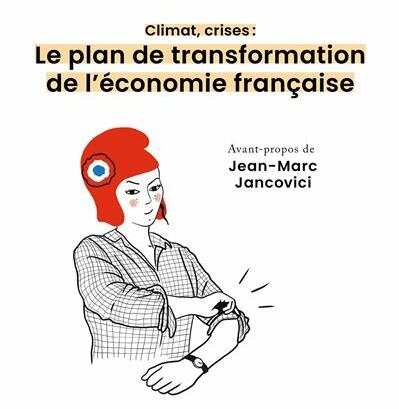 Tim Jackson is a recognised economist and this is probably why his message is so powerful. He does not foresee adjusting the economic margin to include a few “responsible” measures; instead he proposes a radical paradigm shift and develops a full economic model to put the economy back to work for society.
Tim Jackson is a recognised economist and this is probably why his message is so powerful. He does not foresee adjusting the economic margin to include a few “responsible” measures; instead he proposes a radical paradigm shift and develops a full economic model to put the economy back to work for society.
The book contains 12 chapters, all of which develop a precise concept and gradually lead us to see how the author’s thinking comes together.
Chapter 1: Introduction
The first chapter acts as a sort of introduction, in that it announces the elements the author will expand on throughout the book, and which can be summed up by: “reconciling ‘good living’ and the end result”. In our current paradigm, we confuse prosperity with growth of the GDP. But is this still valid when all our fundamental needs are satisfied? And what do we do with inequalities? Developed countries are an “island of wealth in an ocean of poverty”.
The author then studies four occasions when humans had the opportunity to comprehend the planet’s limitations:
- Malthus: he asked interesting questions but was wrong on two points: he did not take into account the inequality problem and he underestimated the growth of the economy (the current economy is 68 times larger than the economy of 1800).
- The Meadows report to the Club of Rome, despite the simplicity of its models, included some very good forecasts.
- The oil peak, producing land and minerals
- Climate change: the author mentions the warning messages of James Hansel and Nicolas Stern.
The system is reaching its limits and it will be very difficult to separate ourselves from it.
Chapter 2: The Age of Irresponsibility
Tim Jackson analyses the financial crisis of 2008:
- The labyrinth of debt (private debt, public debt, and external debt);
- Monetary creation,
- Securitisation, promoted by Alan Greenspan, which helped to mask the gravity of the situation. Greenspan was “shocked” the markets didn’t operate as planned.
Why “The Age of Irresponsibility”? Because, as the CEO of Citibank observed, “when the music stops, in terms of liquidity, things get complicated. […] But while the music’s still playing, you have to get up and dance. We’re still dancing.”
Add to this the ecological debt: long-term blindness is both the same for managing ecological debt and financial debts.
Chapter 3: Redefining Prosperity
Human beings need something more than material security to flourish. Amartya Sen defines three needs:
- Opulence (material satisfaction, with a threshold effect),
- Utility (quantity is not quality, the GDP-Happiness relationship is not a linear one)
- Ability to flourish (but these capabilities are limited to the planet’s capacities).
Chapter 4: The Dilemma of Growth
Is growth a condition that is necessary for us to flourish? The answer to this riddle can be found in the work of anthropologists on “the social language of objects”. “Positional competition has something to do with a zero sum, but reducing inequalities presents benefits that go beyond savings for only the least privileged.
Is there a correlation between growth and elementary rights? By studying the graphs that represent life expectancy, infant mortality, or the level of education according to GDP for all countries, we can see that this correlation is not clear.
Is growth the condition of economic and social stability? While productivity gains, if not compensated for by growth, continue to translate into increased unemployment, the answer is yes.
In short: in an economy that is founded on growth, growth is essential for stability.
The dilemma is the following: growth is unsupportable (at least in its current form) and lack of growth is unstable (at least under current conditions). However, refusing to resolve this would be the worst threat.
Chapter 5: The Myth of Decoupling
A distinction must be made between relative and absolute decoupling. Relative decoupling means achieving additional GDP for the same additional footprint. This does not exclude the rebound effect. Absolute decoupling means raising GDP while lowering the overall footprint in absolute value. And this is much harder!!!
The Ehrlich equation is as follows:
Impact = Population × Abundance (income per head) × Technical factor
Chapter 6: Confronting Structure
The economic driving force in our consumer society is based on innovation on the one hand and a social differentiation logic on the other. There are different types of capitalism, but they all have in common private ownership (for the most part) of the means of production.
The driving force for growth in market economies is summarised in the following scheme:
The share that households do no spend, savings, is used for investment (possibly via an intermediary such as a bank) in companies (this is capital) in order to make gains in productivity over the other two factors of production: work and resources. When a choice needs to be made between these two factors, the relative cost of human labour weighs heavily on the scales and we prefer to invest in machines. If production does not increase by as much, the productivity gains will be converted into unemployment. The economy is therefore condemned to a perpetual forward race….
Planned obsolescence, the acceleration of innovation cycles, and marketing are the system’s survival conditions.
Chapter 7: Keynesianism and the “Green New Deal”
To relaunch growth, rather than count on debt or a mass redistribution of wealth, this chapter outlines the green “New Deal” involving targeted public expenditure and a meaning for the future. The jobs created will contribute to the revival and the wealth produced will have results in terms of well-being for everyone.
Having said that, the revival means return to Business As Usual. It might well be green, but long term it’s not sustainable. We must now create a vision of an economy that generates an absolute decoupling. We are getting to chapter 8 and it is only now that the serious business is starting. The first 7 chapters were only the deconstruction of received wisdom and the introduction of a discussion framework based on new indicators.
Chapter 8: Macro-economics for Sustainability
We start from zero: the definition (or definitions) of GDP are given and its limits are analysed. The chapter recalls the standard economic definition of the “production function” (which takes into account labour and capital but forgets resources).
A service-based economy? We’ve seen what that’s done in the OECD countries: the fall in manufacturing activity has caused industry to be outsourced to developing countries, with the expansion of financial services to pay them. We still need to know what we mean by services: care services, yoga lessons, or hairdressing are not the same as marketing, communications, or finance. The functionality economy will also mean more services provided for fewer material flows.
The isolated growth reduction or voluntary simplicity initiatives that Tim Jackson calls the “Cinderella” economy show that other ways are possible.
Care services have shown a productivity decrease in almost all European countries. If we start to tip over en masse towards this type of activity, it is possible that growth will be greatly impeded. However, this is mostly a question of indicators and not necessarily a problem. If we think about it properly, it is quite logical for these activities to make no gains in productivity: in most cases, the human input is what provides their added value.
Until now, gains in productivity or a recession have translated into unemployment. We must authorise ourselves to play with another lever, working time, and favour a more equitable distribution of available labour rather than a reduction in the number of workers. This option was chosen by Canadian ecological economist Peter Victor, in a scenario of low or zero growth for the Canadian economy.
Significant investments must be made in the areas of energy efficiency, clean technologies, and natural capital, and they must be made at the right speed: quickly enough to avoid mortgaging resources but not so much that the economy ends up on its knees. The government will certainly have an enhanced role in terms of asset ownership investment. Whether or not this investment generates growth is not the question.
Chapter 9: Flourishing – within Limits
This is a tricky chapter as it deals with what we need to change in human nature to keep up with the changes proposed. However, the author manages to avoid falling into a trap and discusses the subject with highly documented and inspired background work.
Western society is facing a “social recession”. The feeling of belonging to a community is weakening. The most unequal societies are experiencing the highest levels of anxiety. In terms of consumption, there will never be a threshold above which we will be able to tell ourselves that “enough is enough”.
However, we are seeing the emergence of new, more frugal lifestyles, based more on internal values than on the consumption of goods. The adepts of this voluntary simplicity are experiencing internal conflict though, since they are going against the values of their social environment. We must not neglect these difficulties.
Chapter 10: Governance for Prosperity
If there is one idea that should be retained from this chapter it is that the government has a role to play, whether it wants to or not, in the orientation of social logic. The question of its legitimacy to initiate the changes that are the subject of the previous chapter must therefore not be taboo.
Chapter 11: Steps towards a Sustainable Economy
Twelve recommendations are outlined here. Not all of them may be implemented unilaterally, but not one of them is without precedent and points of contact with existing initiatives can be found.
- Establish limits in terms of GHG emissions
- Install ecological taxation
- Support the transition in developing countries
- Develop an ecological macro-economic theory
- Invest in jobs, assets, and infrastructures
- Increase financial and fiscal prudence
- Revise national accounts
- Change working time policy
- Combat systemic inequalities
- Measure the capacities for flourishing
- Strengthen social capital
- Dismantle the culture of consumerism
Chapter 12: A Lasting Prosperity
This final chapter acts as a conclusion in that it summarises the main ideas discussed, but most of all it finishes putting together the pieces of the puzzle that has been patiently developed throughout the book.
Consumerist illusionism derives from very powerful mental mechanisms that are difficult to overcome. We must see prosperity as our ability to flourish as humans (within the ecological limits of a finite planet): participation in societal life, a certain degree of security, a feeling of belonging, the ability to share a common undertaking, and the development of our individual potential to be human.
Does this new economic model mean the end of capitalism? It is clear that ecological investments with poor financial yields will be covered by the government (in that the profits are collective rather than being pocketed by the person who owns the capital). The question is not “for or against capitalism?” but “how much capitalism?”. Tim Jackson also quotes Spock in Star Trek: “It’s capitalism, Jim, but not as we know it”.
Conclusion
Tim Jackson has written a book that is beginning to make waves and that must continue to give decision-makers food for thought. The only regret is that it does not grant more importance to a global vision of the question (at several points the figures only relate to the United Kingdom and at others the arguments are only valid for a country in competition with the rest of the world). Also frustrating is the small amount of space given to analysis of the financial crisis and criticism of the solutions provided (to do so, we must read Joseph Stiglitz in “The Triumph of Greed”).
Source : Cédric Ringenbach’s Blog

